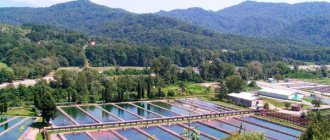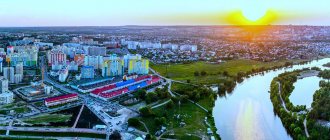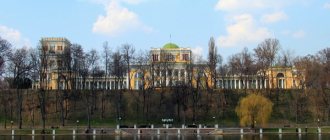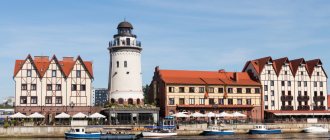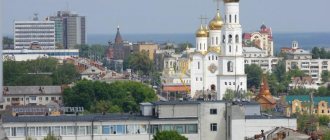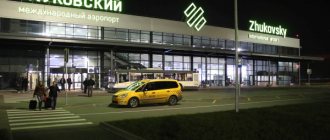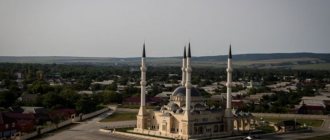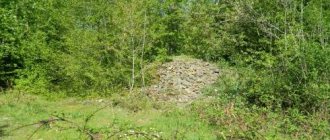Good maps of Kaliningrad with attractions that can be downloaded and printed are rare on the Internet. These are usually poor quality images where it is difficult to see anything. This collection contains tourist maps of Kaliningrad and the Kaliningrad region in good quality, as well as routes for walking around the city, guides and an interactive map with hotel locations.
Read also: Best hotels in Kaliningrad
Kant Island
Kant Island is located in the center of Kaliningrad on the Pregoli (Pregel) River. It was formed by washing the land with two branches of the river. The island is located next to another island – Oktyabrsky. The island received its name in honor of Immanuel Kant, the great scientific thinker and philosopher. Once upon a time it had completely different names in German: Vogswerder, Knipav (1327), Pregelmüne (1333), Kneiphoff.
What interesting things can you see on Fr. Kanta:
- A grave with a monument dedicated to the German philosopher Kant.
- The cathedral with a town hall, which now hosts services of two religious organizations (Evangelical and Orthodox), has its own museum, as well as an ancient organ, which periodically sounds under the hands of different masters. Address: st. Kanta, 1.
- Sculpture Park. There are monuments and pedestals to famous personalities - poets, composers, writers, politicians.
- Arboretum. Beautiful and well-groomed plants, of which there are about 1030 species, not only delight the eye, but amaze with their geometrically correct arrangement.
The last two objects - the arboretum and the Sculpture Park, are located at the address: st. Kant, 26. The grave of the German thinker with monuments in his honor is located near the Cathedral.
Kneiphof was partially destroyed during the Second World War. It was restored by the Soviet authorities after Koenigsberg became Kaliningrad. For example, the cathedral was restored in 1998. The first trestle bridge was built in 1970.
Monuments
List of famous monuments that may be of interest to tourists, with a brief description:
- The monument to Duke Albrecht was erected in 1891 next to the Cathedral.
- Monument to soldiers - internationalists. Located in Yunost Park. It was opened in 1998.
- Monument to Hermann Klaass was built in 1913. Dedicated to the founder of the zoo.
- Monument to Julius Rupp. Dedicated to a rebellious preacher who renounced the church and opened an evangelical community.
- The monument to Peter I is located at the headquarters of the Baltic Fleet. Dedicated to the founder of the Russian fleet.
- Monument to M.I. Kalinin , after whom the city was named, was created in 1946.
Ancient castles
Another highlight of Kaliningrad for tourists is a castle, of which there are dozens. Especially if you take into account the entire region, and not just one city. Some buildings have not survived at all, while others appear only in the form of ruins. But there are also those that are still well preserved or have been restored.
Popular excursions in the city:
- Fall in love with Kaliningrad in 3 hours
- A walk through time: old and new Kaliningrad
- The spirit of old Königsberg
Arriving in Kaliningrad, you can visit the following 9 preserved sites of antiquity:
- Waldau. Erected in 1258, it is a monument to the Teutonic Order. Located in the village of Nizovye on Kaliningradskaya street, no. 20-A. You can arrive from the regional center on route No. 110. In your own (or rented) car, you should move along the A-229 highway and turn off near Rodniki.
Waldau Castle
Popular excursions to the castle:
- Knight's castles of East Prussia
- Journey to the castles of the Teutonic Order
- Georgenburg. Year of construction: 1337. Initially, it was not intended for defense. Therefore, it was not constantly strengthened in the walls and gates, compared to other castles. The castle is not open to tourists because several families live there. Address: Kaliningrad region, Chernyakhovsky district, Chernyakhovsk city, Tsentralnaya street, house No. 4.
- Insterburg. It was built in 1336. It is classified as a water castle because there is a moat with water around it, there is a stream and a mill was installed. The castle was a bastion and a military installation. The location is the same as that of Georgenburg Castle, only Zamkovaya Street, building 1.
- Labiau (1277-1280). Received its name in 1330. Today this object is under state protection (since 1960) as a cultural heritage. Belongs to the Russian Orthodox Church (ROC). Open to visitors as a museum and puppet theater. Address: Kaliningrad region, Polessk, st. Kaliningradskaya, 1.
- Neuhausen. The structure dates back to the 13th century. Located 7 km from the regional center. The architectural appearance is not as refined as other castles. It was rebuilt in the 14th century. Today the castle is a rectangle as a defensive fortification. Address: Kaliningrad region, Guryevsk, st. Zarechnaya, 3.
- Preussisch-Eylau (1325). It is a cultural monument and has been protected by the state since 2007. The condition is deplorable, so we can say that it has hardly survived. Address: Kaliningrad region, Bagrationovsk, st. Brick, 17.
- Tapiau (1265-1258). Since the 15th century it has been used as a prison. Now it has been significantly rebuilt while maintaining the overall appearance. Address: Kaliningrad region, Gvardeysk, st. Dzerzhinsky, 12.
- Taplaken (1336). Initially it was a fortress, after which it was rebuilt into a castle (1530). But the structure retained its shape - a rectangular fortified building with an internal rectangular courtyard, a gable roof, and no turrets. Today the castle is in a dilapidated state. You can inspect it yourself. Address: Kaliningrad region, Gvardeisky municipality, Taplaki village, st. Mira, 14.
- Shaaken (approximately 1258-1261). It is dilapidated and tourists can explore it on their own. Address: Kaliningrad region, Guryevsky district, Nekrasovo village, st. 1st Northern.
Schaaken Castle
There are also many unsurvived copies worthy of attention as historical reference. For example, Königsberg Castle, whose foundation dates back to the 13th century. Destruction in 1968. Belonged to the Teutonic Order. The city was named after this castle. In its place today there is a museum, an observation deck and part of the territory is reserved for excavations. It is customary for historians to read that it was in this castle that the Amber Room was created
A few facts about Kaliningrad
For a long time, the city belonged to Germany, receiving the name Königsberg in 1255. Therefore, there are a lot of German roads left on the streets of the city, which are covered with paving stones. It was annexed to the territory of the Russian Federation in 1946 after the end of the Great Patriotic War. Kaliningrad has no land borders with Russia.
It was in this city that Immanuel Kant lived his entire life, whose grave is located near the Cathedral in Kaliningrad.
Kaliningrad is famous for amber, because... exports it to all countries of the world
Kaliningrad is considered the city of amber, since more than 90% of the world's reserves are located in these places . The museum contains “sun” stones of various sizes and shapes. One of the exhibits reaches 4 kg.
Legendary forts
The city of Koenigsberg-Kaliningrad, from 1255 until the end of World War II, was constantly fortified with a special system - fortifications. These forts are lined up along with gates around the city. When the second defensive ring was built, this system began to be called “the night feather bed of Koenigsberg.”
There are 17 forts in total. Of these, 12 are large objects, and 5 are small. Almost all of them have their names in honor of famous personalities. Here are the 12 largest forts:
- Stein. Name in honor of the Prussian politician (18th century). Open to the public on Sundays. Address: Kaliningrad, Moskovsky Ave., 363.
- Bronzart. Now it is private property, so it is not visited by tourists.
- King Frederick I. Now does not belong to anyone, and can be visited without purchasing tickets. Address: Kaliningrad region, Guryevsky district, Maloe Vasilkovo village.
Fort No. 3 of King Frederick I
- Gneisenau. Named after the Prussian general who became famous at the Battle of Waterloo. Visiting is allowed without purchasing tickets, on your own. Address: Kaliningrad, st. Gorky, 301.
- King Frederick William III. It serves the public as a museum, demonstrating not only the structure itself, but also military equipment. Paid entrance. Address: Kaliningrad, st. A. Nevsky, 232.
Fort No. 5 of King Frederick I
- Queen Louise. Owned by the state. Visits are limited - only the inner courtyards are subject to inspection. Address: Kaliningrad, st. Shady Alley.
- Holstein. It was named after the Duke. Serves the state as a Baltic Fleet facility closed to the public. Address: Right embankment, Kaliningrad.
- King Frederick I. The building is abandoned and dilapidated. You can visit it on your own. Address: Kaliningrad region. village Shosseinoye.
- Don. It is in disrepair. The visit is free. Address: between the villages of Laskino and Dorozhnoe, Kaliningrad region.
- Kanitz. Named after the Prussian minister. The fort is now closed to visitors. Address: Kaliningrad, st. Bolshaya Okruzhnaya (on the road to Bagrationovsk).
- Dönhoff. Closed state facility. Address: Kaliningrad, st. Energetikov, 8-A.
- Eulenburg. Military closed facility. Address: Kaliningrad, Moskovsky district, st. Energetikov, 22.
Fort No. 11 Dönhoff
City officials warn that you should be careful when exploring the dilapidated forts yourself. This is especially true for those vacationers who love to climb onto roofs or ledges in the walls of buildings. Half-collapsed bricks that crumble over time can be dangerous.
Popular excursions visiting forts:
- To the Curonian Spit through forts and castles
- Guardians of Königsberg: underground passages, forts and bastions
- In search of the forts of Kaliningrad - a quest on an SUV
Scenic Gate
Some gates of Kaliningrad are attached territorially to the forts, while others are installed independently. But they all had to protect the city from enemies and perform a border function.
City guests can visit the gates:
- Royal on Frunze Street, 112 - inside the museum;
- Rossgartenskie on Marshal Vasilevsky Square, 1-3 (next to the Amber Museum) - cafe “Sun Stone”.
- Friedlandskie on the street. Dzerzhinsky, 30.
- Zakheimsky on the street. Litovsky Val, 61 – there are cafes “Bread and Turka” and “StolStool” equipped inside.
- Brandenburg (Berlin) on the street. Bagrationa, 137
- Ausfalskie - inside the historical and art museum. Address: Kaliningrad, Gvardeysky Ave., 22-A.
- Railway – now this is the entrance to Victory Park. Address: Kaliningrad, Gvardeysky Ave., 30.
- Steindamsky, Hollanderbaumsky - demolished.
The famous gates of Königsberg
They are all included in the top main attractions of Kaliningrad and the Kaliningrad region; it is very easy to plot a route on a tourist map. The objects are dispersed throughout the city perimeter, but they can be viewed in 1 day.
Friedlandic
A museum is hidden in their depths. Its uniqueness lies in the fact that the exhibition was not assembled purposefully. It consists entirely of things and objects found in old houses, when excavating foundation pits for buildings, and cleaning ponds. Sometimes exhibits are brought in by people who saw them in the attic or basement of their home.
This spontaneous gathering is very interesting, has its own history, and attracts with its spontaneity and homely atmosphere. Temporary exhibitions are regularly held, and visitors are invited to the national event “Museum Night”.
Brandenburg
Only these gates perform their main function, protecting the entrance to the city, located on Bagration Street. They confirm unity with the culture of Germany, repeating the shape of the triumphal gate of the same name on Parisian Square. The building is considered a monument, carefully restored according to surviving drawings and sketches, and has 2 passages. Gothic motifs are softened by an abundance of high reliefs and stone decorative flowers.
Royal
They stand at the crossroads of Frunze Street and Litovsky Val and look impressive. They are shaped like a crown, built in the 19th century, their defensive function did not last long, turning into an element of history with a decorative slant. The decoration consists of sculptural portraits of crowned persons, their personal coats of arms and symbols of the Prussian lands.
Sackheimskie
They are considered a historical monument, built in the 17th century and were part of fortifications. Now they have turned into a platform for exhibitions of contemporary art. Without touching the facade, they were rebuilt inside to host master classes, film festivals, and conferences. A coffee shop is available for guests.
Rossgarten
Outwardly, with their battlements and arches, they resemble the wall of a fortress. Together with the Don Tower, they formed a single architectural ensemble, erected in the 19th century. According to legend, it was through them that Munchausen rode into the city on half a horse.
Gradually the building deteriorated and required repairs. After restoration, the fish restaurant “Solnechny Kamen” was located in the interior.
Friedrichsburg
Once they led to the fortress of the same name on the river bank. Ships are still made on its premises using old drawings and technologies. Two powerful round towers with battlements are reminiscent of its former grandeur and now lead to the Lodeyny Dvor, which also functions as a museum created to preserve maritime traditions. During the tour, you are invited to try your hand at some stages of the restoration or observe from the sidelines. The exhibition includes models of ships, ship logs, and navigation instruments.
Curonian Spit – villages and national park
The Curonian Spit is a fairly narrow saber-shaped strip of land that connects Zelenogradsk in the Kaliningrad region and Klaipeda in Lithuania. Exactly in the middle of the spit there is a border post. It is washed by the Curonian Lagoon, which has more fresh water than salt water. And also the Baltic Sea on its other side.
Geographical parameters of the spit:
- length – almost 100 km (98 km);
- maximum width – 3.8 km;
- minimum width – 350-400 m.
The territory of the spit is considered unique because of its diversity of nature - plants, trees, soil types, animals and birds. Here are the most important features of the Curonian Spit:
Popular excursions on the Curonian Spit:
- National Park "Curonian Spit"
- Curonian Spit for children and adults
- A narrow strip of land that belongs to Russia, except for three villages, is called the Curonian Spit National Park.
- This is one of the most important areas for migratory birds. The migration is monitored by the specially built Fringilla bird station.
- There are three villages here - Lesnoy (formerly Zarkau), Morskoye (Pillokoppen) and Rybachy (Rossiten).
- Two popular heights, Efa and Müller, are landscaped for walking with wooden decks, climbing paths and observation decks.
- On land there is one road leading directly to Klaipeda, straight along the spit.
- The forests are original in that one has ancient trees (Royal Forest), the other has twisted tree trunks (Dancing Forest).
- The Temple of Antiquity (1873), which is now the Orthodox Church of St. Sergius of Radonezh (1999).
- There is a local history museum on site, which is open from 9:00 to 17:00, or longer if it is tourist season (May-October). Entrance fee – 100 rubles. (adult ticket), 70 rub. (children), 150 rub. (preferential – 100 rubles) when visiting the interactive site – the ethno-village of “Sambia”.
Previously, the spit was completely landscaped. Denudation and filling with sand occurred as forests were cut down in the Middle Ages. Now in some places the sand dunes are suspended by legendary figures - Muller and Ef. The length of the Müller dune is 2 km, its height is 44.5 m. The height of the Orekhovoy dune on the Efa Hill is 64 km. The ridge itself stretches 16 km in length. New species of pine trees and other plants capable of attaching roots to the sand layer were imported.
Excursions around Kaliningrad
Kaliningrad (a map with addresses, contacts and opening hours of the main attractions will help the tourist make a route plan) can be visited using the services of travel agencies.
- Museum Dugout. It is a bunker that was built for the defense of the city, on the orders of Otto von Lyash, for which the museum is often called Lyash’s refuge. The museum displays various exhibits. Open seven days a week, every day from 10 am to 6 pm. A school ticket costs 50 rubles, an adult and student ticket costs 150 and 100, respectively. Children under 6 years old are admitted free of charge. Address of the bunker museum: Universitetskaya street 2A.
- Royal Gate. They are one of the few surviving ancient gates; they were built back in 1843. There is a museum on the territory, which displays exhibitions dedicated to various Prussian kings. Children under 16 years of age are admitted free of charge, a ticket for a student is 100 rubles, a regular ticket for an adult is 150 rubles. Address: Frunze Street, 112. You can get there by buses that go to the stop of the same name, namely 28, 45 and 37.
- Königsberg Castle. The castle was the residence of the Czech and Prussian kings. It has a long and unique history. Following a fire, the remains of the castle were demolished in 1968.
Address: Shevchenko street 2, near the Oktyabrskaya stop. You can get there by trolleybuses No. 7, 2 or buses No. 93, 75, 72.
https://www.youtube.com/watch?v=BGT1Ok92FDs
Museum of the World Ocean
The museum was established in 1990. Address: Kaliningrad, emb. Peter the Great, 1. The following facilities are open to tourists:
- The main building with an aquarium, coral exhibitions, museum exhibitions, a storage facility for the Glubina Foundation, and interactive events.
- Navy Pavilion "Cube of Water".
- The Royal Gate, which is directly related to the territory of the Museum - the exhibition "Great Embassy".
- Museum and exhibition, which is located in Svetlogorsk.
- Ships moored specifically as museum exhibits, including the submarine and icebreaker Krasin.
The schedule of visits should be clarified in advance on the official website of the Museum or by phone, +7 (4012) 34-02-44.
Temples
Kaliningrad (map, opening hours and addresses of temples and cathedrals are listed below) is famous for its many attractions, including cathedrals and churches.
- The Kaliningrad Cathedral was founded in 1333. There is a museum on the territory of the cathedral, and organ concerts are held in the small and large halls. The memorial “Kant’s Tomb” is attached to the cathedral. The official website presents a virtual map of the cathedral, with which you can look at it from all angles. Located on Immanuel Kant Street, 1.
- Church of the Intercession of the Blessed Virgin Mary built in Gothic style in 1914. Open every day from 9 am to 6 pm. Located at K. Nazarova Street, 24.
- The Holy Cross Cathedral is located on Oktyabrsky Island. The architectural style combines elements of neoclassical, gothic and late modernism.
Beautiful Amber Museum
The Amber Museum is located in Kaliningrad on Marshal Vasilevsky Square, 1. This institution was established in the Don Tower, a picturesque restored building. The Rossgarten Gate is attached to the tower. The entire complex of cultural and historical significance is located on the shores of Lake Verkhnee.
Here you can see:
- amber collection in the form of stones or products;
- handmade masterpieces;
- competitive, prize-winning works - for example, the panel “Rus”;
- some specimens that date back to antiquity;
- family jewels;
- exhibits of the month;
- exhibitions of famous collectors.
Address of the Amber Museum: Kaliningrad, pl. Marshala Vasilevsky, 1. Open for visitors from 10:00 to 15:00, the ticket office is open until 14:30.
Ethnic Center – Fishing Village
This is a quarter of Kaliningrad-Konigsberg, which was built in the style of ancient Prussia on a stunningly beautiful embankment. At this place there was exactly the same village, which was completely destroyed by Nazi Germany. Now it is recognized as the ethnographic center of the region and for tourists it is one of the primary values on the route. The architecture here is unique - buildings with typical European facades, turrets, weather vanes, streets connected by bridges, decorated with beautiful old lanterns. Construction began in 2006, the village is not yet completed, but a whole block is already ready, open to visitors to the city.
Antiquities of Amalienau
Amalienau is an area of preserved ancient architecture, buildings that once belonged to famous personalities and some noble families in East Prussia. During the flourishing times of Königsberg, this quarter was located outside the city limits. It was built by famous European architects who designed the streets and buildings themselves in Art Nouveau style. Much of the area is built up with villas dating back to the 20th century. Most are beginning to deteriorate so much that they will soon be demolished. Mixed in with them are more modern architecture created in the post-war years.
Popular excursions in the city:
- Amalienau: with love for Königsberg
- Amalienau. Luxury German villas
- Amalienau - the atmosphere of old Königsberg
Churches, temples, cathedrals
Many cathedrals, churches and churches (of the Christian Lutheran direction) are now placed under Orthodox jurisdiction. They have been renovated and restored. One of the notable buildings that has not undergone significant changes by modern superstructures is the Cathedral on Kant Island in the center of Kaliningrad. The amazingly beautiful Gothic building seems to rise up, its architecture is so conducive to such a perception. Construction at the beginning of the 14th century (1333). In the 16th century, it was the most important structure among Protestant religious buildings.
Theaters
The following theaters are located in the city:
- Kaliningrad Regional Musical Theater is located at Mira Avenue, 87. It was opened in 1992 by V.I. Lysenko. The first performance was King Lear.
- Drama theater in Kaliningrad. The year the theater was founded was 1947. It is one of the famous ones throughout Russia. The capacity of the theater's large hall is 930 seats. Located on Mira Avenue, 4.
Parks, arboretums, gardens
In almost every city in the region, as well as in Kaliningrad itself, here and there there are park areas, gardens and arboretums. But that's not all - there is also a lot of wild natural forest in this area. One part of the forestry has been improved by additional import and adaptation of cultivated plants. The other part is left untouched by cultivation, but is only protected and protected (for example, from the advance of sand dunes on the Curonian Spit). As an example, here are a few well-known landscaping areas:
Maps of the Kaliningrad region
Svetlogorsk Map
Map of the city of Svetlogorsk in the Kaliningrad region. Sights, sanatoriums and hotels, banks, travel agencies, etc. are marked.
Map of Polesie region
Scheme with attractions of the Polessky district of the Kaliningrad region:
Map of the Curonian Spit
Map of the city of Gusev
Central Park
Previously, this area, intended specifically for recreation, was called the Louisanval Park. The Altstadt cemetery was also combined with it. At the beginning of the 19th century, on the site that now belongs to the park, the summer residence of one of the royal families was located. Among them, the most famous was Queen Louise of Prussia. There is a church in her honor, built in a modernist style. In the park you can see interesting monuments: the fairy tale character Munchausen and the famous Soviet singer V. Vysotsky. It is also pleasant to stroll past the various fountains with which the park is landscaped.
Yunost Park
The time of creation falls on the post-war years, when the city began to be called Kaliningrad, and not Königsberg. Back in the 80-90s, there was an active recreation area with attractions here. Everything fell into disrepair after perestroika and the collapse of the USSR. In 2004, the park was threatened with complete destruction due to the active construction of new neighborhoods. Now this site is not only preserved, but also completely reconstructed.
Kaliningrad and its surroundings are very rich in various attractions. Coming here, you can get positive impressions and an exciting mini-trip to various historical and significant places. To come here, you just need to study and draw up a route map in advance, check prices for accommodation and meals, and also book hotel rooms. These places are rightly called the most beautiful. The climate of the Russian Baltic states is soft and comfortable.
Popular excursions in the city:
- Kaliningrad. Sightseeing tour
- Underground Königsberg: legends of the old city
- Koenigsberg - a fortified city, a city-museum
Sights of Kaliningrad on the map
Map of the city of Kaliningrad, where the most famous places of the city are marked: temples, cathedrals, museums, parks, ancient bastions, towers, bridges and gates. In addition - shopping centers, restaurants, train station, bus station, Zoo, Kant Island, Fishing Village, etc. Descriptions of the facilities are given in a booklet that can be printed.
A good map of Kaliningrad for tourists. Not as detailed as the previous one, but it shows the forts of Koenigsberg, as well as the opening hours of attractions, museums, etc. This information is summarized on the back of the map and detailed in the guidebook. The map can be printed on a printer on A4 sheet.
Map of Kaliningrad for orientation in the city. The image is schematic, the scale is not maintained, so the picture is only suitable for a rough understanding of what is on which side. The accompanying booklet also contains short descriptions of the objects depicted.
